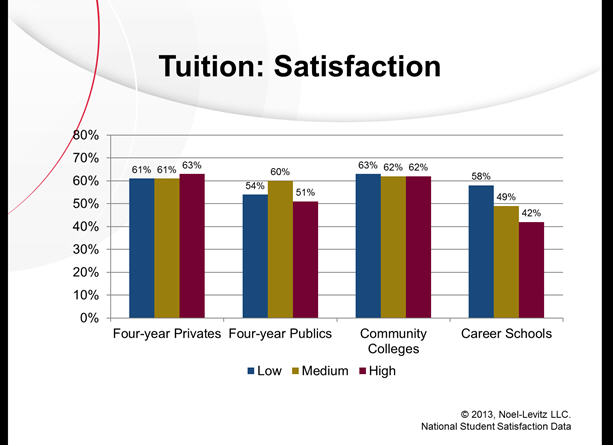enrollment
Do lower college tuition prices increase student satisfaction?
At the 2014 National Conference on Student Recruitment, Marketing, and Retention a couple of weeks ago, my colleague Scott Bodfish and I presented a session entitled, “Do Lower Prices Increase Student Satisfaction?” To answer this question, we looked at national data from the Student Satisfaction Inventory™ within the context of IPEDS data variables. We grouped schools into three categories based on these variables for tuition:
- Low—bottom 25 percent in tuition cost
- Medium—middle 50 percent
- High—top 25 percent
In addition to looking at tuition levels, we looked at graduation rates (see my blog from June 19) and enrollment size to observe differences in satisfaction with these indicators.

There were some interesting observations here. First, satisfaction scores at four-year private institutions and community colleges were relatively steady across all three categories of tuition rates. Four-year publics had a climb in satisfaction in the low to medium group, then a sharp drop from medium to high. For career schools, there was a large decline in satisfaction as tuition increased.
In addition to looking at summary satisfaction scores, we looked at the range in satisfaction scores for specific items.
At four-year privates, the lower the tuition, the more satisfied students were with:
- Financial aid counselors being helpful.
- Tuition paid being a worthwhile investment.
- Billing policies being reasonable.
At four-year publics, the lower the tuition, the more satisfied students were with:
- Adequate financial aid being available for most students.
- Tuition paid being a worthwhile investment.
- Billing policies being reasonable.
At community colleges, the lower the tuition, the less satisfied students were with:
- Generally knowing what is happening on campus.
- Academic advisor being knowledgeable about program requirements.
At two-year career schools, the lower the tuition, the more satisfied students were with:
- Computer labs being adequate and accessible.
- Library resources and services being adequate.
- Tutoring services being readily available.
The items at four-year institutions generally centered on financially-related items, while there were other factors in play at the two-year community colleges and career schools. Students were generally more positive about their experiences at less-expensive career schools than were those who were paying a higher tuition rate.
What these results show us is that lowering your tuition may not automatically increase student satisfaction. You may need to work harder at raising student satisfaction on the perceived value of the education and services you are providing.
I will share observations on how enrollment size and satisfaction scores are connected in a future blog, and will dive into the relationship of student satisfaction to graduation rates, tuition, and enrollment size in a forthcoming paper. If you’d like to be notified when that paper is ready, be sure to subscribe to receive notifications from Noel-Levitz. I also welcome your questions and comments, so please email me if you would like to discuss these findings or student satisfaction assessment.
